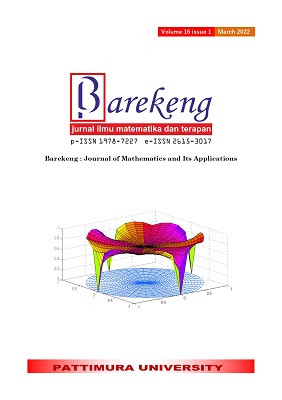ANALYSIS OF WEATHER CHANGES FOR ESTIMATION OF SHALLOT CROPS FLUCTUATION USING HIDDEN MARKOV
Abstract
Climate change has an impact on increasing the temperature of the earth's surface or what is known as global warming. The impact of global warming will affect the pattern of precipitation, evaporation, water run-off, soil moisture and climate variations which are very volatile can threaten the success of horticultural production, especially shallots. Shallots are a strategic commodity but are strongly influenced by fluctuations in production. The development of shallots is one of them constrained by the weather/climate which affects the production of shallots. From these constraints, shallots are also a commodity that contribute significantly to inflation. Hidden Markov Models (HMM) is one of the stochastic processes when the future only depends on condition now, in markov chain all of the element observable, and the probability move to another probability. Prediction and estimation of shallot crops with rainfall input, temperature, and humidity is done with data starting in 2016 until 2020. Estimated shallot crops follows the optimum movement pattern of prediction shallot in each of each variable. The planting months that are usually carried out in the two districts are around February, May, June and September the lowest shallot crops in April or May because transition of rainy to dry season. And the highest shallot crops in October or November. The best accuracy of estimation is rainfall factor with MAPE 5,89% with high accuracy category while 5,84% in MAPE temperature and in 5,55% in humidity factor in category high.
Downloads
References
NationalGeographic,“https://www.nationalgeographic.org/encyclopedia/climate-change/.”
https://www.nationalgeographic.org/encyclopedia/climate-change/.
NASA, “The Effect of Climate Change.” https://climate.nasa.gov/effects/.
M. Chen et al., “A reinforcement learning approach to irrigation decision-making for rice using weather forecasts,” Agric. Water Manag., vol. 250, no. May 2020, p. 106838, 2021, doi: 10.1016/j.agwat.2021.106838.
Y. T. Tseng, S. Kawashima, S. Kobayashi, S. Takeuchi, and K. Nakamura, “Forecasting the seasonal pollen index by using a hidden Markov model combining meteorological and biological factors,” Sci. Total Environ., vol. 698, p. 134246, 2020, doi: 10.1016/j.scitotenv.2019.134246.
O. Stoner and T. Economou, “An advanced hidden Markov model for hourly rainfall time series,” Comput. Stat. Data Anal., vol. 152, p. 107045, 2020, doi: 10.1016/j.csda.2020.107045.
Badan Pusat Statistik Provinsi Jawa Timur, Provinsi Jawa Timur dalam Angka Tahun 2016. Surabaya: Badan Pusat Statistik Provinsi Jawa Timur. Surabaya., 2016.
Badan Pusat Statistik Provinsi Jawa Timur, Analisis Data Bawang Merah dan Cabai Provinsi Jawa Timur 2017. Surabaya: Badan Pusat Statistik Provinsi Jawa Timur., 2017.
Badan Pusat Statistik Provinsi Jawa Timur., Analisis Data Bawang Merah dan Cabai Provinsi Jawa Timur 2018. Surabaya: Badan Pusat Statistik Provinsi Jawa Timur., 2018.
Badan Pusat Statistik Provinsi Jawa Timur., Analisis Data Bawang Merah dan Cabai Provinsi Jawa Timur 2019. Surabaya: Badan Pusat Statistik Provinsi Jawa Timur., 2019.
Badan Pusat Statistik Provinsi Jawa Timur., Statistik Hortikultura Provinsi Jawa Timur 2020. Surabaya: Badan Pusat Statistik Provinsi Jawa Timur., 2020.
S. Andriyas and M. McKee, “Exploring irrigation behavior at Delta, Utah using hidden Markov models,” Agric. Water Manag., vol. 143, pp. 48–58, 2014, doi: 10.1016/j.agwat.2014.06.010.
Kulkarni, Introduction to Modeling and Analysis of Stochastic Systems, vol. 102. 2011.
J. Luo, T. Klein, Q. Ji, and C. Hou, “Forecasting realized volatility of agricultural commodity futures with infinite Hidden Markov HAR models,” Int. J. Forecast., no. xxxx, 2019, doi: 10.1016/j.ijforecast.2019.08.007.
M. Pastell and L. Frondelius, “A hidden Markov model to estimate the time dairy cows spend in feeder based on indoor positioning data,” Comput. Electron. Agric., vol. 152, no. June, pp. 182–185, 2018, doi: 10.1016/j.compag.2018.07.005.
M. Soleimani, F. Campean, and D. Neagu, “Integration of Hidden Markov Modelling and Bayesian Network for fault detection and prediction of complex engineered systems,” Reliab. Eng. Syst. Saf., vol. 215, no. May, p. 107808, 2021, doi: 10.1016/j.ress.2021.107808.
P. Zucchini, W., Guttorp, “A Hidden Markov Model for Space-Time Precipitation,” vol. 27, no. 8, pp. 1917–1923, 1991.
J. W. Hansen, A. Mishra, K. P. C. Rao, M. Indeje, and R. K. Ngugi, “Potential value of GCM-based seasonal rainfall forecasts for maize management in semi-arid Kenya,” Agric. Syst., vol. 101, no. 1–2, pp. 80–90, 2009, doi: 10.1016/j.agsy.2009.03.005.
M. J. Puma and B. I. Cook, “Effects of irrigation on global climate during the 20th century,” J. Geophys. Res. Atmos., vol. 115, no. 16, pp. 1–15, 2010, doi: 10.1029/2010JD014122.
lawrence R. Rabiner., “A Tutorial on Hidden Markov Models and Selected Applications in Speech Recognition,” Neurocomputing, vol. 12, no. 4. pp. 371–373, 1996, doi: 10.1016/0925-2312(96)00016-1.
Badan Pusat Statistik Provinsi Jawa, Provinsi Jawa Timur dalam Angka Tahun 2017. Surabaya, 2017.
Badan Pusat Statistik Provinsi Jawa Timur, Provinsi Jawa Timur dalam Angka Tahun 2018. Surabaya, 2018.
Badan Pusat Statistik Provinsi Jawa Timur, Provinsi Jawa Timur dalam Angka Tahun 2019. Surabaya: Badan Pusat Statistik Provinsi Jawa Timur, 2019.
Badan Pusat Statistik Provinsi Jawa Timur, Provinsi Jawa Timur dalam Angka Tahun 2020. Surabaya: Badan Pusat Statistik Provinsi Jawa Timur, 2020.
A. Stanislavsky, W. Nitka, M. Małek, K. Burnecki, and J. Janczura, “Prediction performance of Hidden Markov modelling for solar flares,” J. Atmos. Solar-Terrestrial Phys., vol. 208, no. July, p. 105407, 2020, doi: 10.1016/j.jastp.2020.105407.
Badan Pusat Statistik Provinsi Jawa Timur, Analisis Data Bawang Merah dan Cabai Provinsi Jawa Timur 2016. Surabaya: Badan Pusat Statistik Provinsi Jawa Timur, 2016.
Authors who publish with this Journal agree to the following terms:
- Author retain copyright and grant the journal right of first publication with the work simultaneously licensed under a creative commons attribution license that allow others to share the work within an acknowledgement of the work’s authorship and initial publication of this journal.
- Authors are able to enter into separate, additional contractual arrangement for the non-exclusive distribution of the journal’s published version of the work (e.g. acknowledgement of its initial publication in this journal).
- Authors are permitted and encouraged to post their work online (e.g. in institutional repositories or on their websites) prior to and during the submission process, as it can lead to productive exchanges, as well as earlier and greater citation of published works.






1.gif)



